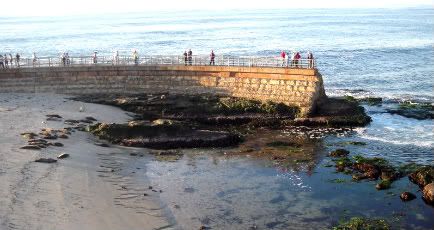
Who has the territorial rights regarding the seal, sea lion life and humans in La Jolla's Children's pool?
The beach, a man made structure, has been closed to swimmers for years, due to bacterial contamination that has been linked to the seals through DNA testing. There are safety issues concerning water quality due to the overwhelming presence of seals. It is clear that the population of Pacific harbor seals have increased over the years.
“In 1997, as beach water testing was begun in California, city officials were forced to close the Children's Pool section of the beach when unsafe pollution levels -- attributed to seal feces -- were detected. The City Council created a temporary reserve around Seal Rock to further protect the seals, which are also protected under the federal Marine Mammal Protection Act.”
The marine mammals that most often come ashore at the Children's Pool beach are Harbor Seals and California Sea Lions. The seals like to "haul out" on the Children's Pool beach all year long. They come to the protected beach when offshore rocks are washed by high surf and corresponding high tides. The seals prefer areas of easy entry and exit such as the Children's Pool beach. The animals need to rest or “haul out” daily when they are tired. During that time period they also use it for breeding, pupping, and molting. Typically they like to haul out for about seven hours a day on Seal Rock, which is the tiny island just off the beach to the north. At higher tides, when Seal Rock and other areas are awash, they move to the Children's Pool beach. The seal and sea lions can however can be very dangerous and unpredictable so people are advised to not get close to them.
“To complicate matters, there is the debate over who has the "right" to use the beach: seals or people." Plus, the fact that the beach has been closed due to contamination from the seals further complicates the situation.
Perhaps until more research is completed, it is impossible to determine long-term affects on the seal colony numbers and behavior of either protecting them as is, or intervening to re-open the beach with possible co-existence.”
Another concern of the La Jolla residents increased last winter with two shark attacks on seals off the beach, which means the seals are attracting sharks. Most importantly, the pool was created so children would have a place to swim a “stipulation included in the state act granting tidal lands used for the project to the city.”
La Jolla Children's Pool Report
Resources
Project Pacific
La Jolla Seals At Children's Pool
Seals and Sea Lions, Frequently Asked Questions
San Diego's Beaches, La Jolla Children's Pool
La Jolla Beach Battle Article
Youtube Video
What are the Best and Worst beaches in San Diego when it comes to cleanliness?
“According to Heal the Bay, a Southern California non-profit organization that monitors California beaches, their annual survey provides essential water quality information to the millions of people who swim, surf, or dive in California coastal waters.”
The “report card” grades over 350 locations year-round on and A-F scale based on the risk of health effects to swimmers and surfers. The grading is based off the daily and weekly fecal bacteria pollution levels in the surf zone. And the results show that most beaches had very good water quality.
“Compared to open ocean beaches, beaches located within enclosed bays tend to have reduced tidal circulation and are more susceptible to long-term pollution problems.”
The “good” beaches that were determined from the testings were San Onofre, Oceanside, Carlsbad, Torrey Pines, La Jolla Shores, Pacific Beach Crystal Pier, Ocean Beach Pier, Coronado, Silver Strand, and Imperial Beach.
Some of the dirtiest beaches included Mission Bay, San Diego Bay, P.B. Point, San Eligo Lagoon Outlet, Tijuana Rivermouth and La Jolla's Children's Beach.
Most Southern California beaches were divided into three categories: open ocean beaches; beaches adjacent to a creek, river, or stormdrain (natural or concrete); and beaches located within enclosed waterbodies. The grades were analyzed for all three time periods.
Dry weather water quality at beaches in San Diego County was very good.
“Of the 65 year round water quality monitoring locations, 86% received good-to-excellent water quality marks. San Diego County’s water quality during the summer dry weather time period was even better, with 90% of the monitored locations receiving an A or B grade”
Long stretches of San Diego County’s beaches showed very-good-to-excellent water quality during the summer dry weather time period.
“There were 9 of 65 locations in San Diego County that received fair-to-poor water quality marks during the year round dry weather time period”
Click the images for a bigger photo.


Heal the Bay Commercial
Resources
San Diego Beach Report Card
Heal the Bay Executive Summary
Heal the Bay - Beach Pollution Patterns
Heal the Bay - San Diego County
Heal the Bay Youtube Video

No comments:
Post a Comment